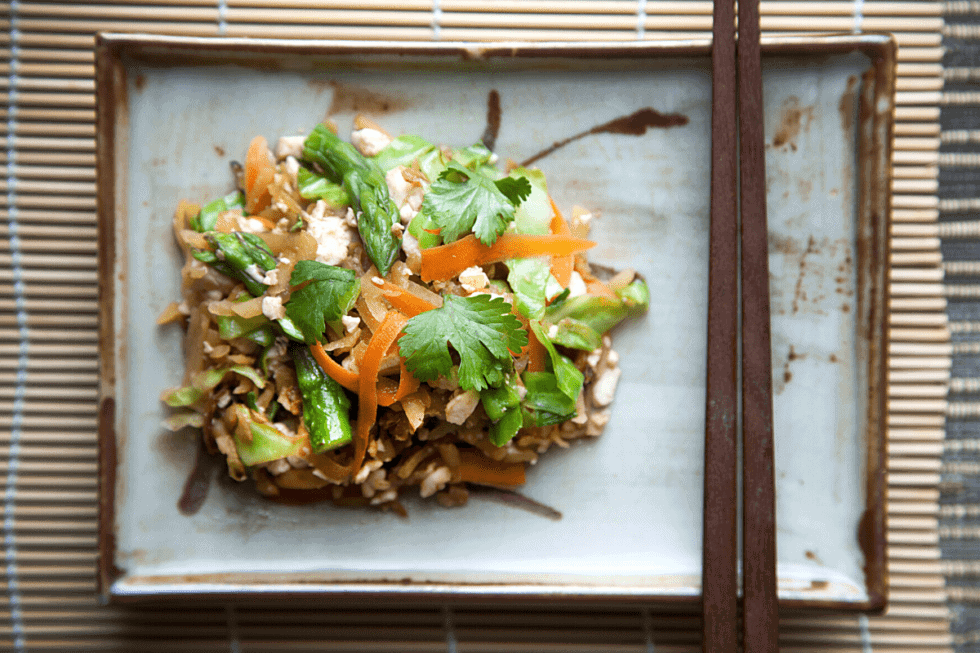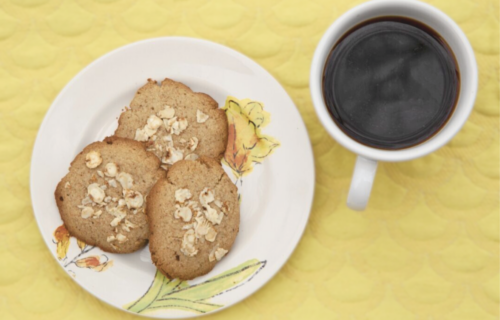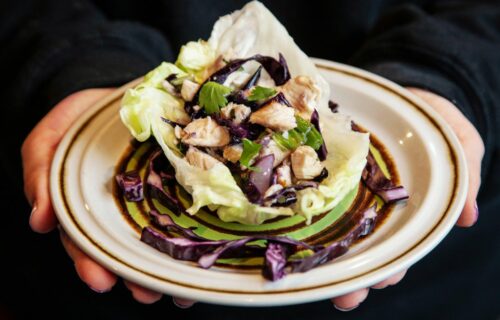
Low Histamine Spring Roll Stir Fry (Also Low Salicylate, Low FODMAP, Low Lectin, Low Oxalate) for people with Mast Cell Activation Syndrome and Histamine Intolerance
Salicylate Intolerance is something I’m seeing more and more in the Mast Cell Activation Syndrome and Histamine Intolerance population. Especially with people who have Mold Toxicity!
A number of my clients have dealt with significant Salicylate Intolerance. When they eat too many salicylates, they get:
- very loud ear ringing
- itching
- rashes
- fatigue
Some of the most common Salicylate Intolerance symptoms are:
- Aspirin allergy
- Ear ringing (tinnitus)
- Nasal congestion
- Sinus infection and inflammation
- Chronic cough
- Itchy skin, hives, or rashes
- Digestive pain and symptoms
- Tissue swelling
- Fatigue
You can learn more about Salicylate Intolerance and which foods are high Salicylate here:
Now, not everyone with Mast Cell Activation Syndrome or Histamine Intolerance has salicylate issues. This is a problem I see in about 10% of my clients.
Many of us in the Mast Cell 360 community are dealing with Histamine Intolerance and Lectin Sensitivity. I’ve also had issues with Oxalates, Glutamates, and FODMAPs.
And if you do add Salicylate Intolerance to that list, it can feel pretty frustrating.
Nearly all herbs and many fruits and veggies are high salicylate.
That can make it hard to get flavor when you have to eat low salicylate.
That’s where this recipe comes in. It’s flavor-packed and should work for nearly all of us dealing with these kinds of food intolerances!
This blog post has a delicious, low-histamine stir fry recipe. And it helps lower histamine, lower inflammation, and helps you detox.
But first, it’s important to keep our ingredients low histamine. Particularly, the chicken.
How to Keep Chicken Low Histamine for People with Mast Cell Activation Syndrome and Histamine Intolerance
First things first: When it comes to histamine, the source of your meat matters! Make sure you are starting with pasture-raised chicken that was frozen right after slaughter.
Learn how meat can cause histamine issues by reading this post:
Are you Raising your Histamine Levels with these Meat Handling Mistakes?
Once you have chicken from a good source, how should you cook it?
Here’s how to keep histamine levels from building up in chicken.
Start with a frozen chicken. You can make a chicken from frozen to finished in 55-90 minutes, depending on the size.
You’ll need an 8-quart Instant Pot to do this. Here’s the recipe for the Lowest Histamine EVER Chicken.
Here’s the Instant Pot to use:
The Instant Pot is a super easy way to make chicken. And it keeps the meat low histamine. You can read about how to do this here:
Instant Pot – Lowest Histamine EVER Chicken/Pork Roast Recipe
You can prepare chicken like this for any meal. And it’s great to freeze after it’s cooked. So, when you need chicken for a recipe (like this one!) all you need to do is thaw.
Low Histamine Chicken Recipes
- Warming Chicken Ginger Soup – Low Oxalate, Low Lectin, and Low FODMAP
- Sesame Chicken Salad – Low Oxalate, Low Lectin, and Low FODMAP
- Rosemary Chicken Salad – Low Histamine, Low Lectin, with Low to Medium Oxalate Options
- Easy Chicken Tacos – Low FODMAP, Low Lectin, Low Oxalate, and Low Salicylate
- Vegetable Korma – Low Lectin, Low Oxalate to Medium Oxalate, with Low FODMAP Option
Okay, now we’ve made sure the chicken is low histamine. Let’s look at a couple of histamine-lowering and mast cell-supporting foods. We’ll be using these in this recipe. Let’s start with cilantro.
Cilantro – What to Know for People with Mast Cell Activation Syndrome and Histamine Intolerance
“Cilantro” is sometimes also known as Chinese parsley.
Now, maybe you said, “Yuck!” the minute I said cilantro. Some people just don’t like the taste. If this is you, you may have the “soap gene!” People with this particular gene think cilantro tastes like soap.
I can understand why you wouldn’t want to include it. So, I’ve got a different option for you. Keep reading.
If you do like cilantro, great! Cilantro is a wonderful herb with antihistamine properties. And it’s known for supporting the body’s detoxification of heavy metals.
In animal studies, cilantro showed some anti-inflammatory properties. There just haven’t been a lot of human studies done on cilantro for inflammation yet.
Cilantro leaf essential oil has also been shown in studies to combat candida. So, if you’re dealing with candida alongside mast cell activation syndrome or histamine intolerance, cilantro may be worth considering.
Next, we’ll look at traditional Mediterranean parsley and its benefits.
Parsley – What to Know for People with Mast Cell Activation Syndrome and Histamine Intolerance
Parsley is another great herb to freshen up any meal. We often see it as a garnish. But parsley can brighten the flavor of a lot of dishes, too.
And parsley is rich in nutrients, including the antihistamine vitamin, Vitamin C. And it’s rich in antioxidants.
Parsley is also rich in a flavonoid called apigenin. Studies show apigenin has been shown to inhibit histamine release. And to lower inflammation.
Some additional health benefits include:
- Digestive support
- Immune support
- Anti-inflammatory
- Blood sugar support
- Liver support
- Brain/cognitive support
- Antibacterial and antifungal
The two main types of parsley are:
- Curly parsley (often used as a garnish)
- Flat leaf/Italian parsley.
If you’re sensitive to oxalates, however, you’ll want to go for the Italian, flat-leaf parsley. The Italian version is lower oxalate for a normal serving size.
Carrots – What to know for Oxalate Intolerance
If you find you are Oxalate Intolerant, you might want to skip the carrots in this recipe.
Alternatively, you may be able to tolerate by separately boiling the carrots if you discard the water.
A half cup of raw carrot is high oxalate. Boiling and discarding the cooking water will reduce to medium oxalate. Remember with oxalates, the amount can influence the oxalate amount so you can always adjust how much you use as well.
How to Make Rutabaga Rice for People with Mast Cell Activation Syndrome and Histamine Intolerance
Rutabaga can sit in storage for a long time. For that reason, you’ll want to choose small, firm ones over large, softer ones. The smaller ones will be lower histamine than the larger ones.
Fun fact: Rutabagas are also known as “swedes” in many parts of the world!
RUTABAGA RICE RECIPE
Ingredients
- 1 medium rutabaga
- Salt to taste (Redmond Real Salt)
Directions
- Peel the rutabaga.
- Chop it into pieces.
- Run it through a food processor with the grater attachment. The food processor grates it into small pieces…Like rice!
You can grate the rutabaga by hand with a grater. But that is going to take a lot of time. And it’s hard work. So, I prefer to use the food processor with the grater attachment.
If you don’t already have a food processor, this is the one I use. It’s worked great for a long time:
Okay! Now that we have our rutabaga rice, it’s time to make our Low Histamine Spring Roll Stir Fry.
Low Histamine Spring Roll Stir Fry (Also Low Salicylate, Low FODMAP, Low Lectin, Low Oxalate) for People with Mast Cell Activation Syndrome and Histamine Intolerance
Ingredients
- 1 bunch asparagus, optional (omit for low FODMAP)
- 1 carrot, shaved (medium salicylate; optional)
- 2 Tablespoons ghee
- 2 cloves garlic, crushed (substitute garlic infused olive oil for low FODMAP, but won’t be low Salicylate)
- 2 cups “riced” rutabaga
- 2 cups shredded green cabbage
- 2 cups shredded chicken, cooked
- 1 teaspoon Redmond Real Salt
- 2 green onions, chopped (use green tops only for low FODMAP)
- Several sprigs fresh organic cilantro, chopped
- Several sprigs fresh Italian flat leaf parsley, chopped
Directions
- Steam asparagus until nearly done. Take off heat. Drain and set aside.
- Melt ghee in a medium non-stick, non-toxic skillet. Add garlic and cook for about 60 seconds. (If using garlic infused EVOO, drizzle it on at the end).
- Add riced rutabaga and shredded green cabbage. Stir fry on medium-high heat for about 5 minutes. You want some light crunch.
- Add chicken, salt, green onions, and steamed asparagus and carrot shavings, if using. Mix together and heat until warm.
- Sprinkle chopped herbs on top.
- If using garlic-infused EVOO, drizzle on top.
- Enjoy and be sure to freeze your leftovers!
What did you think of this recipe? I’d love to hear from you in the comments below!
Feeling stuck? Be sure to check out the Mast Cell Nervous System Reboot for the #1 biggest missing piece for people with sensitivities!
More Low Histamine Recipes
- Rosemary Roasted Garlic Pork Chops – Low Oxalate, Low Lectin
- Low Histamine Bacon with Southern Greens –Low Oxalate, Low Lectin
- Roasted Cauliflower with Cherries and Pecans – Low Lectin, Lower Oxalate, with Low Salicylate Option
- Pizza – Low Oxalate, Low Lectin
- Baru Nut Crusted Chicken Over Salad – Low FODMAP, Low Lectin, Low to Medium Oxalate Options
Some links in this website are affiliate links, which means Mast Cell 360 may make a very small commission if you purchase through the link. It never costs you any more to purchase through the links, and we try to find the best deals we can. We only recommend products that we love and use personally or use in the Mast Cell 360 practice. Any commissions help support the newsletter, website, and ongoing research so Mast Cell 360 can continue to offer you free tips, recipes, and info. Thank you for your support!
References for Low Histamine Spring Roll Stir Fry (Also Low Lectin, Low Oxalate, Low FODMAP, Low Salicylate) for People with Mast Cell Activation Syndrome and Histamine Intolerance
Cardenas, H., Arango, D., Nicholas, C., Duarte, S., Nuovo, G. J., He, W., Voss, O. H., Gonzalez-Mejia, M. E., Guttridge, D. C., Grotewold, E., & Doseff, A. I. (2016). Dietary Apigenin Exerts Immune-Regulatory Activity in Vivo by Reducing NF-κB Activity, Halting Leukocyte Infiltration and Restoring Normal Metabolic Function. International journal of molecular sciences, 17(3), 323. https://doi.org/10.3390/ijms17030323
Eriksson, N., Wu, S., Do, C.B. et al. A genetic variant near olfactory receptor genes influences cilantro preference. Flavour 1, 22 (2012). https://doi.org/10.1186/2044-7248-1-22
Freires, I., Murata, R. M., Furletti, V. F., Sartoratto, A., Alencar, S. M., Figueira, G. M., de Oliveira Rodrigues, J. A., Duarte, M. C., & Rosalen, P. L. (2014). Coriandrum sativum L. (Coriander) essential oil: antifungal activity and mode of action on Candida spp., and molecular targets affected in human whole-genome expression. PloS one, 9(6), e99086. https://doi.org/10.1371/journal.pone.0099086
Hwang, E., Lee, D. G., Park, S. H., Oh, M. S., & Kim, S. Y. (2014). Coriander leaf extract exerts antioxidant activity and protects against UVB-induced photoaging of skin by regulation of procollagen type I and MMP-1 expression. Journal of medicinal food, 17(9), 985–995. https://doi.org/10.1089/jmf.2013.2999
Life Extension. (January 2017). Apigenin: Another Reason to Go Green. Life Extension website. Retrieved from: https://blog.lifeextension.com/2017/01/apigenin-another-reason-to-go-green.html
Mauer, L., El-Sohemy, A. Prevalence of cilantro (Coriandrum sativum) disliking among different ethnocultural groups. Flavour 1, 8 (2012). https://doi.org/10.1186/2044-7248-1-8
Omura, Y., & Beckman, S. L. (1995). Role of mercury (Hg) in resistant infections & effective treatment of Chlamydia trachomatis and Herpes family viral infections (and potential treatment for cancer) by removing localized Hg deposits with Chinese parsley and delivering effective antibiotics using various drug uptake enhancement methods. Acupuncture & electro-therapeutics research, 20(3-4), 195–229. https://doi.org/10.3727/036012995816357014
Sreelatha, S., & Inbavalli, R. (2012). Antioxidant, antihyperglycemic, and antihyperlipidemic effects of Coriandrum sativum leaf and stem in alloxan-induced diabetic rats. Journal of food science, 77(7), T119–T123. https://doi.org/10.1111/j.1750-3841.2012.02755.x
Zhang, E., Zhang, Y., Fan, Z., Cheng, L., Han, S., & Che, H. (2020). Apigenin Inhibits Histamine-Induced Cervical Cancer Tumor Growth by Regulating Estrogen Receptor Expression. Molecules, 25(8), 1960. doi:10.3390/molecules25081960




Hello! I’m allergic to chicken. Would this work with ground turkey or beef? If so, which is better? Can chicken alternatives please be listed on your other recipes?